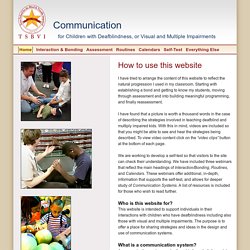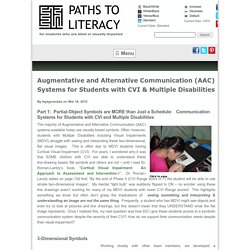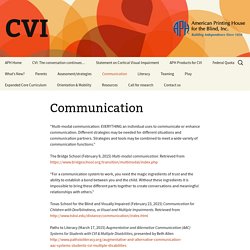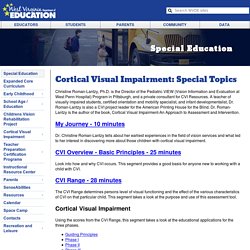

Home - Communication for Children with Deafblindness or Visual and Multiple Impairments - a TSBVI website. I have tried to arrange the content of this website to reflect the natural progression I used in my classroom.

Starting with establishing a bond and getting to know my students, moving through assessment and into building meaningful programming, and finally reassessment. I have found that a picture is worth a thousand words in the case of describing the strategies involved in teaching deafblind and multiply impaired kids. With this in mind, videos are included so that you might be able to see and hear the strategies being described. Augmentative and Alternative Communication (AAC) Systems for Students with CVI & Multiple Disabilities.
Part 1: Partial-Object Symbols are MORE than Just a Schedule: Communication Systems for Students with CVI and Multiple Disabilities The majority of Augmentative and Alternative Communication (AAC) systems available today use visually based symbols.

Often, however, students with Multiple Disabilities including Visual Impairments (MDVI) struggle with seeing and interpreting these two-dimensional, flat visual images. This is often due to MDVI students having Cortical Visual Impairment (CVI). For years, I wondered why it was that SOME children with CVI are able to understand these line-drawing based, flat symbols and others are not – until I read Dr. Roman-Lantzy’s book, “Cortical Visual Impairment: An Approach to Assessment and Intervention”.
REVISEDChristineRomanWorkshopPackage1. CVIRangeHannah. Additional Links to Resources CPR AAC 20150528. CollaborativeTeaming AAC Design 20150528. Kidz Learn Language: June is Vision Health Month. Are You Looking at Your Student's Vision? June is Child Vision Awareness Month.

Vision is a very important sense for all of us, but even more so for our AAC users. Those who need to use pictures to communicate rely more heavily on vision to maintain their attachment to social interaction and engagement.Yet many of the students we see with Complex Communication Needs have vision issues that are not related at all to their visual acuity.
Vision, more than any other system, allows the individual to take in massive amounts of stimuli from the environment for the brain to act upon. PrAACtical Resources: High Contrast Core Vocabulary Board : PrAACtical AAC. Many of our AAC learners struggle with vision issues which makes it a challenge for us to create effective communication and visual supports.

So when SLP Rachael Langley offered to share her high contrast core vocabulary, we jumped at the chance. You can download her board here. Communication. “Multi-modal communication: EVERYTHING an individual uses to communicate or enhance communication.

Different strategies may be needed for different situations and communication partners. Strategies and tools may be combined to meet a wide variety of communication functions.” The Bridge School (February 9, 2015) Multi-modal communication. Cs visonaac(1) CVI : PrAACtical AAC. Tanna Neufeld hits another homerun with this post about co-treating children with multiple disabilities.

Collaborating with our colleagues is both fun and challenging. Let’s take a look at the prAACtical ways that Tanna and her colleagues support kids with motor and visual impairments who are learning to use AAC. Office of Special Projects - Blind and Low-Vision Services. Christine Roman-Lantzy, Ph.D. is the Director of the Pediatric VIEW (Vision Information and Evaluation at West Penn Hospital) Program in Pittsburgh, and a private consultant for CVI Resources.

A teacher of visually impaired students, certified orientation and mobility specialist, and infant developmentalist, Dr. Roman-Lantzy is also a CVI project leader for the American Printing House for the Blind. WVDE Video Player. CVI AAC Costello John .pdf. 33. Newsletter 34. LindaJohnCVIhandout. Empoweraac.